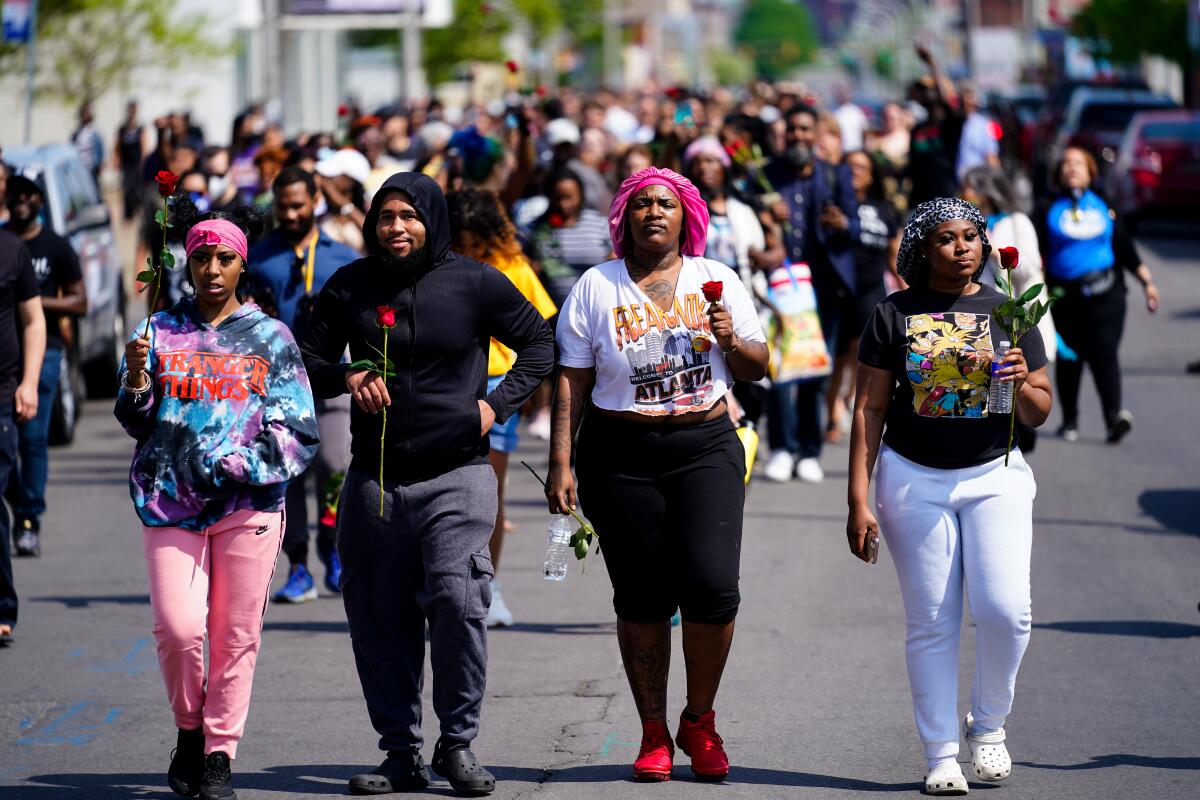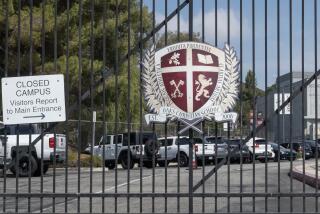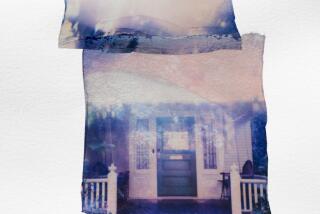Op-Ed: How ’14 Words’ brought white supremacy to Thousand Oaks

The heavily armed gunman who opened fire Saturday in a Buffalo, N.Y., grocery store — and is suspected of killing 10 victims in a racially motivated attack — had the number 14 written on his semiautomatic rifle. It is a reference to the popular white supremacist slogan known as the “14 Words” and a call to action to defend the white race.
As a reporter for a weekly community newspaper in Thousand Oaks, I have become all too familiar with the 14 Words this year because white supremacists have been demonstrating in my town. A group that calls itself White Lives Matter unfurled its hateful message from the Borchard overpass on the 101 Freeway in February and March.
Unlike the Buffalo shooter, they didn’t come to kill. They came to recruit, law enforcement officials said.
At my church on Sunday, the pastor prayed for those mourning in Buffalo since they had joined the grim fraternity of cities that, like ours, now know the unspeakable horror and inescapable grief of a mass shooting. On Nov. 7, 2018, a Marine veteran opened fire at the Borderline Bar and Grill in Thousand Oaks, killing 12. Our town still weeps.
The White Lives Matter demonstrators, men hiding behind face masks, used drones to capture footage of their actions as they unfurled a banner over the 101 Freeway and performed training exercises in a nearby public park. Some wore shirts from the Rise Above Movement, a far-right street-fighting gang that spreads white supremacist propaganda. The footage they filmed in Thousand Oaks was used in recruiting videos posted online.
The Thousand Oaks Police Department and some city officials were quick to label the WLM demonstrations the work of outsiders. Police scans of license plates showed three of the four cars associated with their actions were from out of town. But the city had a link to the demonstration: A member of a WLM forum who lives in Thousand Oaks, and had been previously arrested for a hate crime, appeared to play a backstage role, say local anti-fascists researchers.
The white supremacists didn’t choose our city at random. They were invited by one of their own.
For the last five years, I have covered the Thousand Oaks community, and from speaking with hundreds of residents and business owners, I can tell you with some certainty that WLM is not welcome here nor does it represent the views of the majority of residents in our relatively quiet, tree-filled suburb that abuts the Santa Monica Mountains.
Yet why did a hate group feel comfortable unfurling racist banners in our community?
After the first demonstration, the Thousand Oaks City Council passed a resolution condemning hate. More than 50 public speakers weighed in. I heard residents of color share stories of being subjected to discrimination, of being called the N-word as they walked down the street, of facing ethnic taunts related to the origins of COVID-19, but I also heard white residents say racism isn’t an issue here.
And yet, like many Southern California towns, Thousand Oaks has racism in its past.
In the 1920s, the Ventu Park Club Cabins, a small campground and resort in the Thousand Oaks neighborhood of Newbury Park was a summer getaway for Los Angeles residents; a racial covenant ensured sales were “limited to the Caucasian race.” In the 1970s, the greater Thousand Oaks region grew as white families fled the Los Angeles Unified School District to avoid busing and school desegregation.
More recently, someone reportedly broke into the press box at the Newbury Park High School stadium in 2017 and broadcast a recording of a speech by Adolf Hitler over the football field’s loudspeaker. Last year, school district officials issued a statement condemning the use of racial slurs on local campuses.
After the murder of George Floyd in May 2020, two men employed by the Ventura County sheriff’s department and the district attorney’s office were cited for vandalizing a Black Lives Matter banner. In March, a Newbury Park man pleaded guilty to hate-crime-related charges that included a racially motivated attack on an elderly Black man.
Hate crime charges are not common in Thousand Oaks, but his guilty plea offered more concrete evidence that racists live among us. Swastikas have become such a common form of graffiti, the Nazi symbol must be routinely painted over on our playgrounds and public property, sometimes multiple times a week.
Unlike Ventura County as a whole, Thousand Oaks — a city of 130,000 people — is majority non-Hispanic white. Thousand Oaks is more racially segregated today than it was in the 1990s, according to the city’s own analysis of its housing patterns. Some schools are more than 80% Hispanic while others are more than 70% white.
To stop perpetuating the injustices of the past, the city and its residents need to unflinchingly examine why they continue to occur. We can’t just look away. Last year, Thousand Oaks formed an advisory committee to discuss issues such as racial and health equity, and people have begun speaking out about the racism they see here. It’s a start.
WLM had signaled another day of action for last Saturday, reported anti-fascists who have infiltrated the group’s online forums. Once they learn the dates of upcoming demonstrations, they plan counterprotests. On days when WLM is expected to demonstrate, a retired Amgen scientist gets to the freeway overpass early in the morning to hang a banner bearing not 14 words, but just two: one love.
Those words were hanging over the 101 Freeway when the gunman opened fire a continent away in a predominantly Black neighborhood in Buffalo.
Dawn Megli is a reporter for the Acorn newspapers in Thousand Oaks and a Ventura County native.
More to Read
A cure for the common opinion
Get thought-provoking perspectives with our weekly newsletter.
You may occasionally receive promotional content from the Los Angeles Times.










